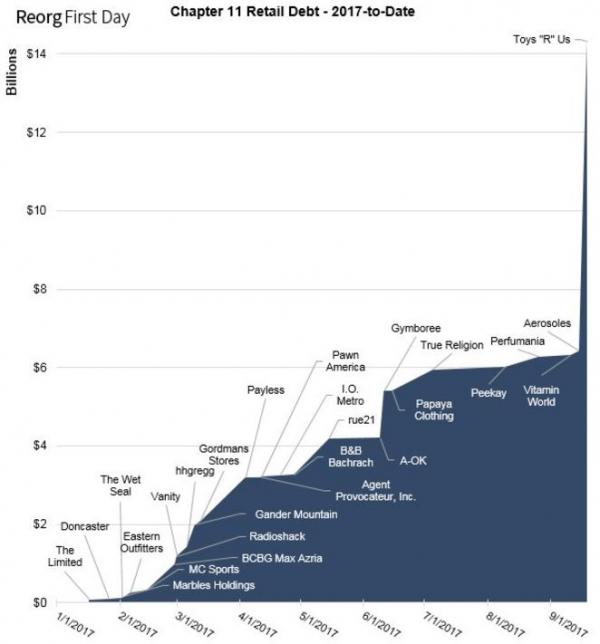
Summer closed in a whirlwind of weather chaos for the United States and its territories. At the start of the summer, the US economy began to show signs that it was flying apart. The two most obvious were the big blowouts in the auto industry and in retail, not all of which could be attributed to a shift to online sales.
Carmageddon crashes on
The auto industry rolled over this year and began a decline similar to the one we experienced at the start of the Great Recession. (See “Carmageddon Crashes into ‘the Recovery’ Right on Schedule.”)
In response, car markers started offering record incentives (like $0 down, 0% interest on a 80-month loan), which brought an improvement to sales in July. You have to ask, just as I did back in 2007, “What is the end game when such incentives take profit down to nil?”
Used car prices, on the other hand (not having such major incentives), plunged to their lowest level since 2009. New car prices have also fallen all year (as another part of the major incentives) and dropped almost a thousand dollars on average just between June and July (as part of the incentives package).
Even with such pricing and financing incentives, one firm, SouthBay Research, threw cold water on the Census Bureau’s July sales report, declaring the figures “unbelievable.”
Over the summer, delinquencies also spiked on “deep sub-prime auto loans” (now matching — like so many other things in the auto industry — their crisis-era milestone from 2007). Delinquencies rose across all credit scores, but these things always hit worse at the bottom and eventually work their way up. Is it any wonder “deep sub-prime” delinquencies are up, given the old 2007 tricks that dealers and financiers began offering this summer as yet another incentive? Look at the following ad:
That’s right. If you have a really bad credit score, you get an extra $1,500 off! Let’s bait the people who can least afford to purchase a $40,000 truck into taking out a loan by offering them a reward for having bad credit.
It was hurricanes to the rescue this year however, as Harvey and Irma wiped out something like a million automobiles. Those will for the most part be quickly replaced, effectively shifting the auto manufacturers’ problems for this year over to the insurance companies who will pay for most of that replacement and to uninsured individuals who will pony up if they can in order to stay in transportation. The hurricanes will force many people and businesses to make car and truck purchases they would not otherwise have made … if they can somehow swing a little more debt. (They’d better hope they have bad credit in order to make it a little easier.)
The hurricanes will not, however, solve any of the auto manufacturers’ troubles for next year. In fact, they likely make next year worse by moving purchases up. (See “Hurricanes Harvey and Irma May Lend Helping Hand to Economy.”)
Retail apocalypse now
Summer also deepened the retail apocalypse that I wrote about earlier and that has become the economic topic of the year. (See “Retail Apocalypse Engulfs US Economy.”) JC Penny reported in August that its latest quarter receded further. Macy’s and Kohl’s reported similar results. Shares of all companies tumbled on the news.
Sporting Goods Stores joined the big clothing stores in a cacophony of bad news. Dicks Sporting Goods reported horrible results and saw its stocks plunge, and Dicks notably did not hold out hope that the worst was behind it. Instead, it slashed its future guidance lower than the lowest sell-side forecasts. Sad quarterly results from two other sporting goods stores — Hibbett and Foot Locker — confirmed Dicks’ longterm assessment of the brick-and-mortar sporting goods market.
“Athletic apparel and footwear is over-distributed and there is too much inventory in the channel,” John Zolidis, president of research firm Quo Vadis Capital Inc, wrote in a note. “We see potentially several years of retrenchment as supply is reduced to meet the new, lower level of demand…. We predict several years of pain for the companies that compete in this arena.” (Zero Hedge)
Even kids toys took a major tumble, unable to hold out for the next holiday season. As the end of summer neared, Toys “R” Us crumpled like a dry autumn leaf almost overnight. So it appeared, but these things are long in development and merely held out of sight as long as possible. As Zero Hedge laid out,
The company spends millions of dollars every month on expensive lawyers … investment bankers … turnaround advisors … claims administrators, etc., who all spend many sleepless nights in the days leading up to a [chapter 11 bankruptcy] filing…. CEO David Brandon explains why Toys “R” Us was forced to file for bankruptcy in such a hurry…. Debt … “Toys ‘R’ Us … has been operating for more than a decade with significant leverage, necessitating the use of substantial amounts of cash each year….” But these substantial debt service obligations impair the Company’s ability to invest in its business and future.
As ZH wryly noted, “Apparently spending … on debt service while ignoring capital improvements and store remodels is a bad long-term business strategy.” I’ve been noting for a couple of years on this blog that there would prove to be a severe down-the-road cost from so many companies using low interest rates to invest in stock buybacks to create the illusion of higher profits and to make shareholders rich the easy way, instead of using those loans to do the hard work of research, development, and capital improvements. So, who woulda thunk that stock buybacks are not a longterm plan for corporate success?
As John Rubino of the Dollar Collapse blog wrote,
Long credit cycles like the current one always end with a crash. But first they deteriorate. The headline numbers remain positive while under the surface a growing list of sectors start to falter. It’s only when the latter reach a critical mass that market psychology turns dark. How far along is this process today? Pretty far, it seems, as some high-profile industries roll over.
Given how leveraged many companies have become as they chose to buy up their own stocks during the recovery, rather than invest in capital, one must wonder what retail company has lawyers working overnight right now in order to become the next to fold overnight. Ah, well, this one was just a toy company. How much can that matter in an adult world?
Answer: About this much …
Toys “R” Us is, in fact, the third largest retail bankruptcy in US history. Will Sears and Kmart (Sears Holdings) be next? (Sears Canada, which spun off as an independent company in 2012, already filed this past summer.) That would be déjà vu for Kmart.
The state of the [Sears] company is so poor that a warning was issued to investors that said, “Historical operating results indicate substantial doubt exists related to the company’s ability to continue.” (Seeking Alpha)
Retail bankruptcies in the US are up about 30% so far this year, according to BankruptcyData.com.
The rocky road ahead for retail
Of course, the worst for retail in 2017 will come in the decisive fourth quarter when all profits for the year are usually made. Stores that weathered through a rough 2016 holiday season, hoping for a 2017 season that would give them a comeback, will fall through the floor when 2017 fails to provide fourth-quarter salvation for the those starving companies that have managed to hold on.
Closely related to retail in that they share the same shopping areas, restaurants haven’t reported a single positive month since February 2016. That slide actually became more pronounced this summer with both sales and foot traffic declining. Chain restaurants, which tend to be located more around shopping centers and malls, performed the worst.
CEO Ed Stack said “we have conducted extensive consumer research, and the customers have told us they feel our prices are not competitive in today’s environment” in which everyone is slashing price to capture market share…. Having no other choice, Dicks has joined the battle of the “deep discounters….” Of course, by doing so, the retailer assures that both Dick’s and its peers margins and net income shrink even more in the coming quarters. (Zero Hedge)
So, the major economic cracks that I predicted for the summer of 2017 began right on schedule and gaped open much wider during the summer. The worst is certainly ahead as millions of hurricane victims will not have a lot of spending money for the holidays with more pressing needs to focus on.
Likewise, already marginal retail stores and restaurants and even malls that were physically wiped out will choose to stay closed, rather than re-open in those stricken areas. Commerce will not rebuild to the degree that existed before the hurricanes because keeping the insurance money for lost inventory and/or capital structures will appear much more desirable to brick and mortar stores that were already going broke and are now literally broken brick and mortar.
And then there is Puerto Rico, a US territory that was already in the throes of bankruptcy with a public power company that was also in the throes of bankruptcy now having to rebuild parts and pieces of everything. Puerto Rico is pretty much eligible for all the same assistance that states are.
Into this darkening world of woes, the Fed’s new austerity skulks into our presence like a Halloween cat, as Grandma Yellen finally begins to claw back the money she magically created out of thin air. And October, a month known for surprises, explodes into our presence with the worst lone-gunman massacre in US history — not an economic problem exactly and yet the very kind of thing I predicted last January would be the most horrible change in 2017 — an upsurge in the severity and intensity of domestic violence.
First, we saw it in the violent rallies that formed around President Trump’s inauguration, then in the dark advent of Antifa. We don’t yet know the motive of this latest killer, but yesterday brought a rise in the level of a single individual’s evil action beyond anything this nation has seen before. And this man was a millionaire — a real estate developer — part of the top ten percent or maybe even the one percent. He was not known to have mental issues or to be strongly religious or political. What did he have to be so upset about?
And, yet, just as President Trump had the White House flag lowered to half mast and mourned the Las Vegas massacre as an “act of pure evil,” the insane stock market shook all this off and partied on to clock a 152-point gain in the Dow and a record close. As if we needed some absolute proof that the stock market is completely unhinged from reality! The sheer screaming mania of that should send a chill to your bones.







